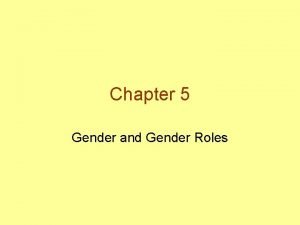Gender and Speech 2 AS Paper 2 The

































- Slides: 33

Gender and Speech 2 AS Paper 2

The Dominance Model Exemplified by • Zimmerman and West • Dale Spender

This is theory that in mixed-sex conversations men are more likely to interrupt than women, as shown by Zimmerman and West (1975). They report that in 11 conversations between men and women, men used 46 interruptions, but women only two. They found in their data that 96% of all interruptions in mixed-sex conversations were made by men.

They saw this as a sign that women had restricted linguistic freedom and that men sought to impose their dominant status through putting explicit restraints on their female counterparts. Most subsequent research into this approach has concluded that men and women do not hold equal conversational rights. Dale Spender builds on this. She identifies power with a male patriarchal order in society, and states that language embodies structures that sustain male power.

Who is dominating/being dominated AND who would interrupt more…? A classroom of 19 students with a female teacher A classroom of 19 students with a male teacher A court of law with a male witness and a female judge An office with a female employee and a male boss A group of 5 friends 4 are male 1 is female A group of 5 friends 3 are male 2 are female A group of friends all are female A father talking to his two young daughters A mother talking to her two teenage sons

However, this research is often contested: "The problem with this is that you might simply have one very voluble man in the study which has a disproportionate effect on the total…Why do interruptions necessarily reflect dominance? Can interruptions not arise from other sources? Do some interruptions not reflect interest and involvement? " – Geoffrey Beattie

Beattie found that women and men interrupted with more or less equal frequency. Men did interrupt more, but by a margin so slight as not to be statistically significant. Yet Beattie's findings are not quoted as often as those of Zimmerman and West. Why is this? Is it because they don’t fit with what someone wanted to show…!?

William O'Barr and Bowman Atkins studied the language of the courtroom and found female lawyers to be assertive and interrupt. They also found that witnesses of both sexes would use Robin Lakoff's weak "female" language. They concluded that these weak language traits are actually a "powerless language" rather than a "female language".

Personality and Social Psychology Review - 2007 Men tended to talk more in conversations between spouses or partners, those that included people of both sexes and situations where the topic involved disagreement. Women dominate over men when they were among classmates, parents and children and when the topic of conversation required a discussion of feelings.

The Difference Approach Objectives: To re-cap on the Dominance and Deficit approaches To understand the Difference approach, exploring how male and female language is simply different rather than ‘blaming’. Focussing on Tannen but looking at some other researchers.

Learning Checkpoint In mixed-sex conversations men are more likely to interrupt than women. Zimmerman and West Women's speech is deficient in relation to a male norm. Lakoff DOMINANCE THEORY DEFICIT THEORY

DOMINANCE THEORY: In mixed-sex conversations men are more likely to interrupt than women. Zimmerman and West DEFICIT THEORY: Women's speech is deficient in relation to a male norm. Lakoff

The Difference Approach Exemplified by Deborah Tannen

The Difference Approach Men and women belong to different sub-cultures and preferences. This approach avoids “blaming” men for being dominant, and avoids suggesting women’s speech is inferior.

Deborah Tannen (1990) You Just Don’t Understand: Men and Women in Conversation • Controversial – looked at mixed-gender conversation. • She attempts to explain “male-female miscommunication” by claiming that male-female speech is “cross-cultural communication”.

Status vs. Support. Men see conversation as a contest, women do not think of the people they converse with as ‘trying to get one up on them’. Independence vs. Intimacy. Men see consulting with their partner to be ‘asking for permission’ rather than simply discussing. Advice vs. Understanding. To many men a complaint is a challenge to come up with a solution, but often women are looking for emotional support, not solutions. Information vs. Feelings. To men, talk is information. It has a practical purpose, and if it does not…it’s just not worth saying! Orders vs. Proposals Women hedge their orders, “Let’s…”. Men can feel that by doing this, a woman is trying to slyly manipulate him to do something rather than just directly ask, like he would. Conflict vs. Compromise. Women are reluctant to openly oppose others See handout

Personal Study Task 1 Look at the summary of Tannen’s book You Just Don’t Understand: Men and Women in Conversation. Identify which area is being outlined in the each page summary.

Jennifer Coates (1989) Jennifer Coates looks at allfemale conversation and builds on Deborah Tannen's ideas. • All female-talk is cooperative: speakers negotiate discussions and support each other’s rights as speakers. • These patterns are not found in mixed- sex talk.

Ann Weatherall • Women's talk is co-operative. • Men's talk is competitive. • Women are more likely to use hedging, "sort of" "kind of". . . • Women speak for less time and are less likely to interrupt. • Females use more tag questions: F: We're seeing Mum later, aren't we? M: We're going to see Mum today.

Jane Pilkington (1992) Pilkington did research into all female and all male conversation in a bakery over a period of nine months. She found: • Women talk to affirm solidarity and maintain social relationships. • Women focus on feelings, personal anecdotes and relationships. • Women support, build on each others' points and complete others' utterances • Women agree frequently. • Men find long pauses (thinking time) acceptable. • Men frequently disagree and challenge others' points. • Their conversation is competitive to a point of verbal abuse. They take part in verbal sparring, often using mock insults. You don't have to agree with them and pointing out in the exam the problems with the studies (e. g. that they're generalising, that they're dated) would also get you marks

Christine Howe • Men have strategies for gaining power. • Men are much more likely to respond to what is being said, keen to put their views across. • This makes it harder for the listener to participate in the conversation. • Women are more active listeners. They use minor interjections, such as "uh huh" and "oh really" (back-channeling). • The differences between male and female conversation begins at socialisation (ages 3 -4).

Koenraad Kuiper (1991) • Studied all-male talk amongst a rugby team. • Men pay less regard to the need to save face and use insults as a way of expressing solidarity.

Learning Tool See features of transcripts handout on Moodle.

RECAP: Conversation Theory Accommodation Theory - It was developed by Howard Giles and suggests that we accommodate the person we are addressing. - This will result in convergence or divergence. Convergence is when we move our speech closer to that of the other person whereas divergence is when people’s speech styles move further apart.

Convergence What is the effect of convergence? - It results in decreasing the social distance between people e. g. an RP speaker may tone down his accent when in the company of working class people. This is referred to as downward convergence. - On the other hand, a person with a strong regional accent who is being interviewed for a job by an RP speaker may eliminate some regional features from his speech. This is upward convergence. - If two participants converge towards each other, this is mutual convergence. Think of other examples where upward and downward convergence may occur.

The Cooperative Principle H. P. Grice (1975) saw cooperation between the participants as the fundamental principle underlying conversation. He believed that conversations proceed because those taking part have common goals and agreed ways of achieving these goals. He developed his idea by identifying four specific maxims which he said participants in a conversation usually follow: - Maxim of quantity - Maxim of relevance - Maxim of manner - Maxim of quality

The Four Maxims - The maxim of quantity refers to the fact that in a conversation we should neither say more nor less than is required. - The maxim of relevance states that we say should be relevant to the context of the conversation. - The maxim of manner refers to avoiding ambiguity and obscurity in speech. - The maxim of quality states that we should be truthful and not tell lies.

The Four Maxims When we do not follow these principles, the maxims are said to be flouted. This can lead to disruption within a conversation. - We are aware of these principles in everyday speech e. g. I’ll not talk for long but…’, ‘I know this isn’t relevant…’. - Flouting the maxims can sometimes lead to difficulties in a conversation e. g. ‘get to the point’. - However, in some situations a person may appear to be flouting the rules but may well be cooperating e. g. someone looking for directions to a post office may get a response of ‘it’s Sunday today’. This is called implicature.

The Diversity Model Exemplified by Deborah Cameron

Cameron's’ book ‘The Myth of Mars and Venus’ examines and tries to dispose of several myths about supposed linguistic differences between the sexes, which are presented in John Gray’s book ‘Men are from Mars, Women are from Venus’. These myths (folklingustics) include: 1 Language and communication matter more to women than to men; women talk more than men. 2 Women are more verbally skilled than men. 3 Men’s goals in using language tend to be about getting things done, whereas women’s tend to be about making connections to other people. Men talk more about things and facts, whereas women talk more about people, relationships and feelings. 4 Men’s way of using language is competitive, reflecting their general interest in acquiring and maintaining status; women’s use of language is cooperative, reflecting their preference for equality and harmony. 5 These differences routinely lead to “miscommunication” between the sexes, with each sex misinterpreting the other’s intentions. This causes problems in contexts where men and women regularly interact, and especially in heterosexual relationships.

The Diversity approach (based on Deborah Cameron’s The Myth of Mars and Venus) presents gender as just one aspect of identity amongst many, and reminds us that there can be as many differences between two women as between a man and a woman. You can find this book in the library.

Personal Study Task 2 Read the PDF document on Moodle which examines a more modern approach to gender and speech. Current research takes the dynamic approach. According to this viewpoint, gender isn’t something that one has, but something one does. Gender identity is created by society and ever changing. Everyone uses a range of speech patterns that can be broadly classified as “male” and “female. ”

Janet Hyde
 Strategic gender needs and practical gender needs
Strategic gender needs and practical gender needs Gender preferential speech features
Gender preferential speech features Aice english paper 2
Aice english paper 2 Aice general paper hand approach
Aice general paper hand approach Match the verbs with the prepositions
Match the verbs with the prepositions Pure speech definition
Pure speech definition Reported speech statements and questions
Reported speech statements and questions Simple past in reported speech
Simple past in reported speech Direct to indirect speech imperative sentences
Direct to indirect speech imperative sentences Reported speech
Reported speech Quoted speech vs reported speech
Quoted speech vs reported speech Hình ảnh bộ gõ cơ thể búng tay
Hình ảnh bộ gõ cơ thể búng tay Ng-html
Ng-html Bổ thể
Bổ thể Tỉ lệ cơ thể trẻ em
Tỉ lệ cơ thể trẻ em Voi kéo gỗ như thế nào
Voi kéo gỗ như thế nào Chụp tư thế worms-breton
Chụp tư thế worms-breton Alleluia hat len nguoi oi
Alleluia hat len nguoi oi Các môn thể thao bắt đầu bằng tiếng bóng
Các môn thể thao bắt đầu bằng tiếng bóng Thế nào là hệ số cao nhất
Thế nào là hệ số cao nhất Các châu lục và đại dương trên thế giới
Các châu lục và đại dương trên thế giới Cong thức tính động năng
Cong thức tính động năng Trời xanh đây là của chúng ta thể thơ
Trời xanh đây là của chúng ta thể thơ Mật thư anh em như thể tay chân
Mật thư anh em như thể tay chân Làm thế nào để 102-1=99
Làm thế nào để 102-1=99 Phản ứng thế ankan
Phản ứng thế ankan Các châu lục và đại dương trên thế giới
Các châu lục và đại dương trên thế giới Thể thơ truyền thống
Thể thơ truyền thống Quá trình desamine hóa có thể tạo ra
Quá trình desamine hóa có thể tạo ra Một số thể thơ truyền thống
Một số thể thơ truyền thống Cái miệng nó xinh thế chỉ nói điều hay thôi
Cái miệng nó xinh thế chỉ nói điều hay thôi Vẽ hình chiếu vuông góc của vật thể sau
Vẽ hình chiếu vuông góc của vật thể sau Biện pháp chống mỏi cơ
Biện pháp chống mỏi cơ đặc điểm cơ thể của người tối cổ
đặc điểm cơ thể của người tối cổ























































